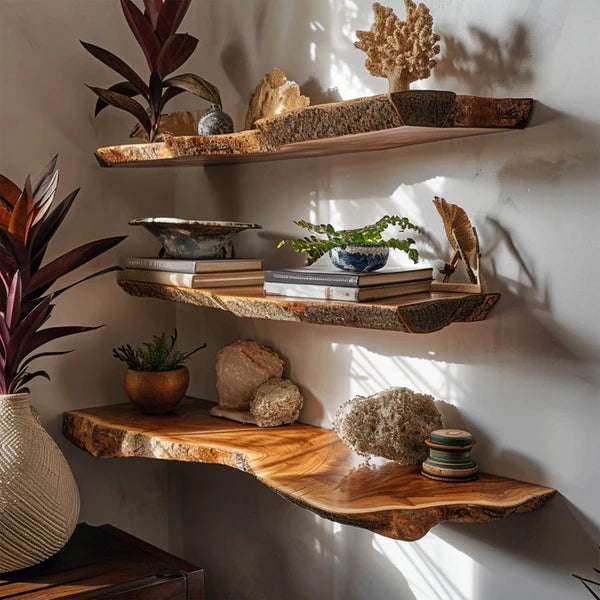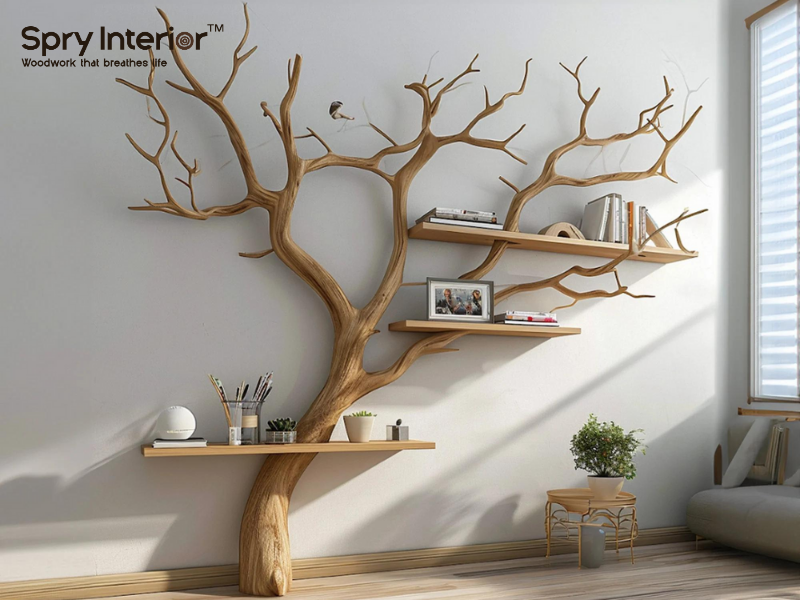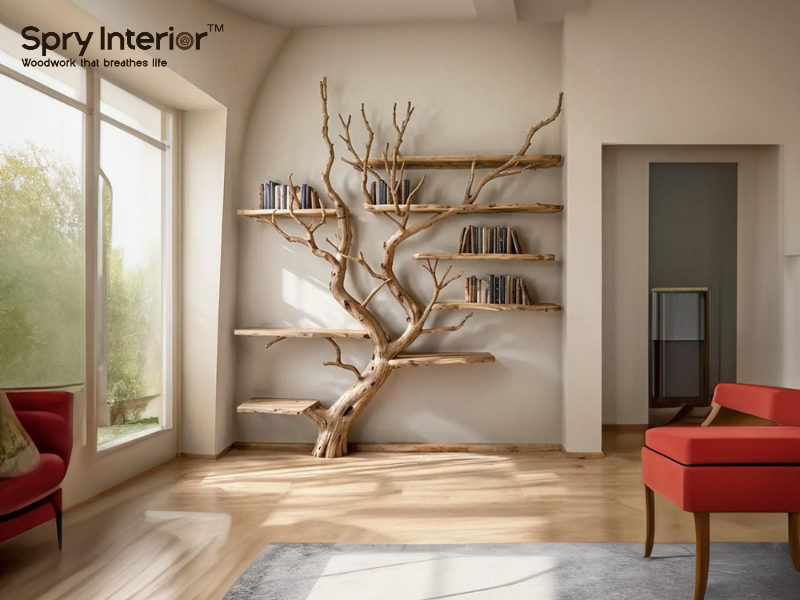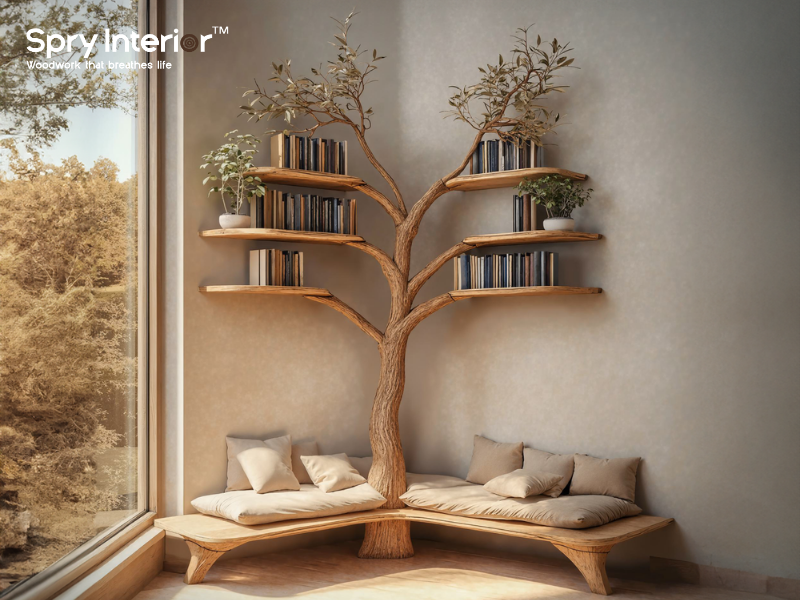When diving into natural design elements or simply exploring tree anatomy, many people ask, "What's the difference between a tree branch and a tree limb?" While the two terms are often used interchangeably, there are subtle but significant distinctions that can make a big difference, especially when using them in home decor or DIY woodworking projects.
Understanding these differences not only helps with general knowledge but is also essential when selecting the right materials such as for a tree branch wall shelf or rustic furniture. In this article, we’ll take a closer look at tree structure, definitions, applications, and how you can incorporate natural wood elements into your home especially with the help of SpryInterior.
Defining the Tree: Anatomy and Terminology
Trees are more than just trunks and leaves. They are complex living organisms with structured growth and specific terminology. Understanding the distinction between a limb and a branch starts with understanding how trees grow and function.
What Is a Tree Limb?
In the world of arboriculture, a tree limb refers to the primary structural extension from the tree trunk. Limbs are typically thick, strong, and serve as the main support system from which smaller branches grow. They are the large “arms” of the tree, helping support the tree’s overall shape and spreading its canopy.
Easy Bookcase Tree Build | Build Tree Bookshelf Tutorial | 2025's Must-Have
Tree limbs are essential to a tree’s survival. They carry water and nutrients from the trunk to outer parts of the tree and are integral in distributing weight. When people refer to large parts of a tree breaking in storms, they're often talking about limbs, not just small branches.
What Is a Tree Branch?
A branch, on the other hand, is usually a secondary growth that stems from a limb. Branches are generally smaller in diameter and more flexible than limbs. They extend the reach of a tree’s canopy and are where leaves and smaller twigs are most commonly found.

Branches play a key role in photosynthesis by supporting leaves and flowers. They also serve as the parts of the tree most often used in crafting or decorative work, including the creation of pieces like a tree branch wall shelf or DIY art projects.
How They Connect in Tree Hierarchy
To break it down simply, the tree’s trunk gives rise to limbs, and from those limbs come branches. From branches, you get smaller twigs. So while all limbs are branches, not all branches are limbs. The distinction comes down to size, strength, and position in the tree’s structure.
Practical Differences in Use and Appearance
The differences between limbs and branches aren't just academic; they’re important when selecting materials for home projects, interior design, and woodworking.
Weight and Stability Considerations
Tree limbs are thicker and heavier, making them more suitable for load-bearing furniture or large-scale design projects. If you're building something like a chair base, table leg, or structural beam for a rustic-themed space, limbs offer the necessary strength and stability.

Buy now: Driftwood Branch Tree Bookshelf Wall Mounted Shelf
Branches, being lighter and more manageable, are ideal for decorative uses. Their organic shapes and thinner forms lend themselves well to art pieces, wall hangings, or shelving features like a tree branch wall shelf.
Texture and Shape
Tree branches tend to have more variation in texture and shape, which is why they’re favored in decorative contexts. Their unpredictable curves and bark patterns make them visually interesting and highly customizable.

Buy now: Tree Bookshelf Floating Shelves Driftwood Branch
Limbs, due to their thickness and central role in tree structure, have smoother lines and less deviation. When cut and cleaned, they often appear more uniform, which is beneficial for clean-lined rustic furniture but less dynamic than the aesthetic appeal of branches.
Cutting and Handling Differences
Due to their size and weight, tree limbs require more effort to cut and handle. They typically need power tools and more space to work with. Branches, however, can often be cut with hand tools and are easier to manage during crafting and installation.
This practical difference is particularly important for DIYers asking, "How to hang tree branches on a wall?" Branches are significantly easier to manipulate, mount, and position without requiring professional tools or heavy-duty anchors.
Branches and Limbs in Interior Design
Whether you're going for a rustic, boho, or nature-inspired aesthetic, natural wood elements like limbs and branches bring a unique, organic charm to interiors. However, their applications differ based on their structure.
Decorative Use of Tree Branches
Tree branches are ideal for creating lightweight, decorative pieces. They can be transformed into coat racks, light fixtures, or mounted directly onto walls. When you’re exploring "How to hang tree branches on a wall?", it’s often as simple as using wall anchors or brackets that support the natural shape of the branch.
Branches are also used to create art installations or focal points in minimalist spaces, where a single twisted branch can add dramatic character without cluttering the room.
Functional Use of Tree Limbs
Larger tree limbs are excellent for creating robust functional furniture. Their strength makes them suitable for supporting shelves, constructing bed frames, or acting as curtain rods with a rustic edge.

Buy now: Mid Century Bookcase Tree Branch Shelf Mini Bookcase
Because of their bulk, limbs are more often used in grounded furniture pieces rather than wall decor, unless properly anchored and supported. Their clean lines and smooth finish also make them perfect for blending rustic charm with a more polished modern look.
Tree-Inspired Shelving
When choosing between a limb or a branch for wall shelving, the answer depends on the purpose. If the shelf is purely decorative and will hold lightweight items like books or candles, a tree branch works beautifully. It not only supports the weight but adds an artistic flair.
However, if you’re looking for a heavy-duty shelf or a piece of furniture built into the wall, a tree limb might be more appropriate. In design terms, a tree-sourced shelf whether from a limb or branch; adds a natural edge to any room and answers the question, "What is a shelf in a wall called?" It’s often referred to as a recessed shelf or built-in shelf, but when made from organic materials, it becomes much more than that it becomes a statement piece.
Why SpryInterior Is the Right Choice for Nature-Inspired Design
When it comes to incorporating nature into your living space, SpryInterior brings craftsmanship, expertise, and creativity together. Whether you're decorating with tree branches or seeking a fully finished natural wood furniture piece, we leads the way in both aesthetics and durability.
Ethically Sourced Natural Wood
SpryInterior prides itself on sourcing wood responsibly. Whether it’s a delicate tree branch or a robust tree limb, every material used is ethically harvested and processed with minimal environmental impact. This commitment ensures that your home reflects not only great style but also conscious living.
Customized Designs Tailored to You
Every space is different, and SpryInterior understands that. That’s why they offer custom-made tree-inspired designs. Whether you’re envisioning a tree branch wall shelf, a reclaimed limb coffee table, or a tree bookshelf installation, we turn ideas into reality, perfectly scaled and styled to your space.

Built for Durability and Elegance
SpryInterior products are built to last. By combining traditional woodworking with modern finishing techniques, each piece brings natural elegance with long-term usability. The balance between raw wood texture and sleek design ensures that each product elevates your interior, both visually and functionally.
Conclusion
So, what's the difference between a tree branch and a tree limb? It comes down to size, strength, and function. Limbs are thicker and more structural, while branches are lighter, more decorative, and versatile for DIY projects. Understanding this difference helps you make smarter choices when incorporating natural elements into your home.
Whether you're creating a rustic wall feature, building a statement shelf, or just curious about nature’s design, recognizing the role of branches and limbs opens up a world of possibilities. For those looking to integrate these elements with precision, beauty, and sustainability, SpryInterior's Tree Bookshelf and other handcrafted wood decor options are the perfect solutions. Let nature guide your interior design with the right expertise, it can transform any space.








Leave a comment
This site is protected by hCaptcha and the hCaptcha Privacy Policy and Terms of Service apply.